The NVIDIA GeForce GTX 980 Review: Maxwell Mark 2
by Ryan Smith on September 18, 2014 10:30 PM ESTCompute
On the other hand compared to our Kepler cards GTX 980 introduces a bunch of benefits. Higher CUDA core occupancy is going to be extremely useful in compute benchmarks. So will the larger L2 cache and the 96KB per SMM of shared memory. Even more important, compares to GK104 (GTX 680/770) GTX 980 inherits the compute enhancements that were introduced in GK110 (GTX 780/780 Ti) including changes that relieved pressure on register file bandwidth and capacity. So although GTX 980 is not strictly a compute card – it is first and foremost a graphics card – it has a lot of resources available to spend on compute.
As always we’ll start with LuxMark2.0, the official benchmark of SmallLuxGPU 2.0. SmallLuxGPU is an OpenCL accelerated ray tracer that is part of the larger LuxRender suite. Ray tracing has become a stronghold for GPUs in recent years as ray tracing maps well to GPU pipelines, allowing artists to render scenes much more quickly than with CPUs alone.

Out of the gate GTX 980 takes off like a rocket. AMD’s cards could easily best even GTX 780 Ti here, but GTX 980 wipes out AMD’s lead and then some. At 1.6M samples/sec, GTX 980 Ti is 15% faster than R9 290X and 54% faster than GTX 780 Ti. This, as it’s important to remind everyone, is for a part that technically only has 71% of the CUDA cores of GTX 780 Ti. So per CUDA core, GTX 980 delivers over 2x the LuxMark performance of GTX 780 Ti. Meanwhile against GTX 680 and GTX 780 the lead is downright silly. GTX 980 comes close to tripling its GK104 based predecessors.
I’ve spent some time pondering this, and considering that GTX 750 Ti looked very good in this test as well it’s clear that Maxwell’s architecture has a lot to do with this. I don’t know if NVIDIA hasn’t also been throwing in some driver optimizations here, but a big part is being played by parts of the architecture. GTX 750 Ti and GTX 980 both share the general architecture and 2MB of L2 cache, while it seems like we can run out GTX 980’s larger 96KB shared memory since GTX 750 Ti did not have that. This may just come down to those CUDA core occupancy improvements, especially if you start comparing GTX 980 to GTX 780 Ti.
For our second set of compute benchmarks we have CompuBench 1.5, the successor to CLBenchmark. We’re not due for a benchmark suite refresh until the end of the year, however as CLBenchmark does not know what to make of GTX 980 and is rather old overall, we’ve upgraded to CompBench 1.5 for this review.
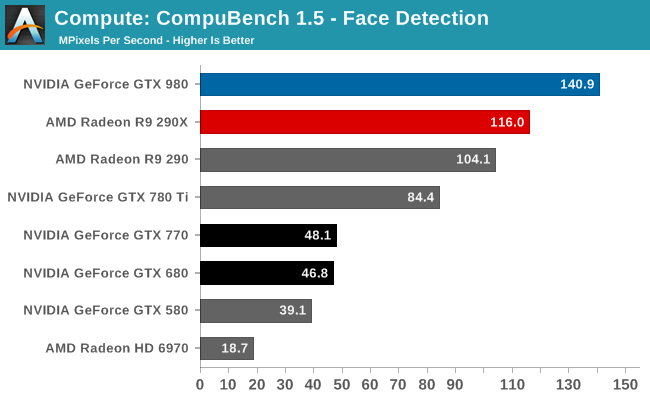
The first sub-benchmark is Face Detection, which like LuxMark puts GTX 980 in a very good light. It’s quite a bit faster than GTX 780 Ti or R9 290X, and comes close to trebling GTX 680.
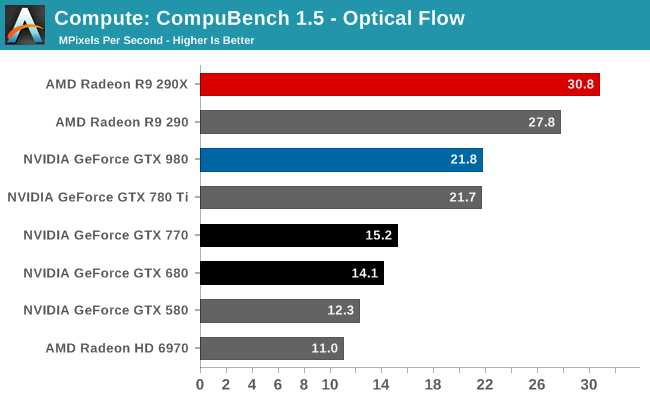
The second sub-benchmark of Optical Flow on the other hand sees AMD put GTX 980 in its place. GTX 980 fares only as well as GTX 780 Ti here, which means performance per CUDA core is up, but not enough to offset the difference in cores. And it doesn’t get GTX 980 anywhere close to beating R9 290X. As a computer vision test this can be pretty memory bandwidth intensive, so this may be a case of GTX 980 succumbing to its lack of memory bandwidth rather than a shader bottleneck.
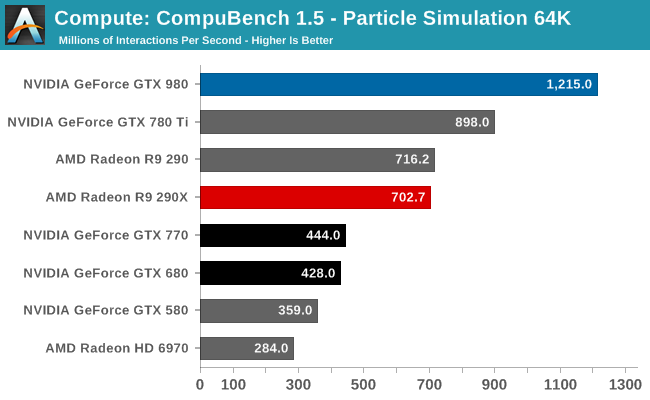
The final sub-benchmark of the particle simulation puts GTX 980 back on top, and by quite a lot. NVIDIA does well in this benchmark to start with – GTX 780 Ti is the number 2 result – and GTX 980 only improves on that. It’s 35% faster than GTX 780 Ti, 73% faster than R9 290X, and GTX 680 is nearly trebled once again. CUDA core occupancy is clearly a big part of these results, though I wonder if the L2 cache and shared memory increase may also be playing a part compared to GTX 780 Ti.
Our 3rd compute benchmark is Sony Vegas Pro 12, an OpenGL and OpenCL video editing and authoring package. Vegas can use GPUs in a few different ways, the primary uses being to accelerate the video effects and compositing process itself, and in the video encoding step. With video encoding being increasingly offloaded to dedicated DSPs these days we’re focusing on the editing and compositing process, rendering to a low CPU overhead format (XDCAM EX). This specific test comes from Sony, and measures how long it takes to render a video.
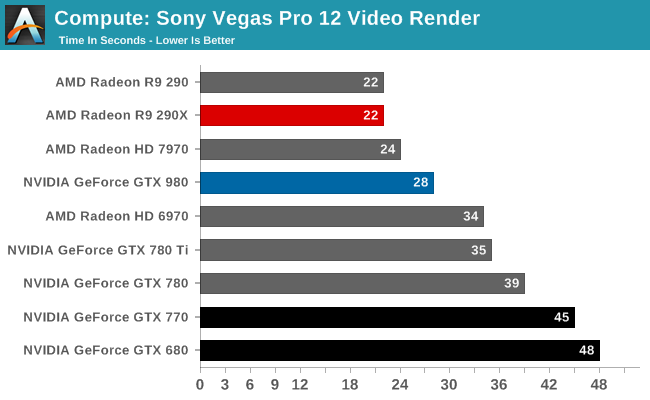
Traditionally a benchmark that favored AMD, the GTX 980 doesn’t manage to beat the R9 290X, but it closes the gap significantly compared to GTX 780 Ti. This test is a mix of simple shaders and blends, so it’s likely we’re seeing a bit of both here. More ROPs for more blending, and improved shader occupancy for when the task is shader-bound.
Moving on, our 4th compute benchmark is FAHBench, the official Folding @ Home benchmark. Folding @ Home is the popular Stanford-backed research and distributed computing initiative that has work distributed to millions of volunteer computers over the internet, each of which is responsible for a tiny slice of a protein folding simulation. FAHBench can test both single precision and double precision floating point performance, with single precision being the most useful metric for most consumer cards due to their low double precision performance. Each precision has two modes, explicit and implicit, the difference being whether water atoms are included in the simulation, which adds quite a bit of work and overhead. This is another OpenCL test, utilizing the OpenCL path for FAHCore 17.
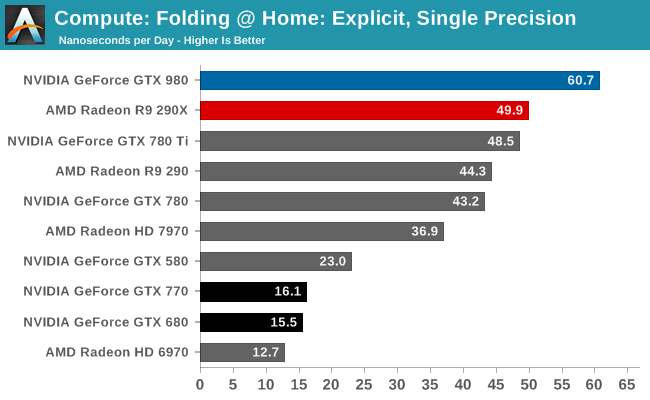
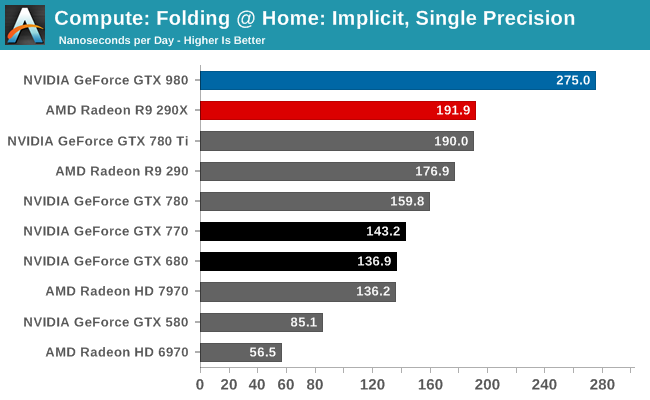
This is another success story for the GTX 980. In both single precision tests the GTX 980 comes out on top, holding a significant lead over the R9 290X. Furthermore we’re seeing some big performance gains over GTX 780 Ti, and outright massive gains over GTX 680, to the point that GTX 980 comes just short of quadrupling GTX 680’s performance in single precision explicit. This test is basically all about shading/compute, so we expect we’re seeing a mix of improvements to CUDA core occupancy, shared memory/cache improvements, and against GTX 680 those register file improvements.

Double precision on the other hand is going to be the GTX 980’s weak point for obvious reasons. GM204 is a graphics GPU first and foremost, so it only has very limited 1:32 rate FP64 performance, leaving it badly outmatched by anything with a better rate. This includes GTX 780/780 Ti (1:24), AMD’s cards (1:8 FP64), and even ancient GTX 580 (1:8). If you want to do real double precision work, NVIDIA clearly wants you buying their bigger, compute-focused products such as GTX Titan, Quadro, and Tesla.
Wrapping things up, our final compute benchmark is an in-house project developed by our very own Dr. Ian Cutress. SystemCompute is our first C++ AMP benchmark, utilizing Microsoft’s simple C++ extensions to allow the easy use of GPU computing in C++ programs. SystemCompute in turn is a collection of benchmarks for several different fundamental compute algorithms, with the final score represented in points. DirectCompute is the compute backend for C++ AMP on Windows, so this forms our other DirectCompute test.

Once again NVIDIA’s compute performance is showing a strong improvement, even under DirectCompute. 17% over GTX 780 Ti and 88% over GTX 680 shows that NVIDIA is getting more work done per CUDA core than ever before. Though this won’t be enough to surpass the even faster R9 290X.
Overall, while NVIDIA can’t win every compute benchmark here, the fact that they are winning so many and by so much – and otherwise not terribly losing the rest – shows that NVIDIA and GM204 have corrected the earlier compute deficiencies in GK104. As an x04 part GM204 may still be first and foremost consumer graphics, but if it’s faced with a compute workload most of the time it’s going to be able to power on through it just as well as it does with games and other graphical workloads.
It would be nice to see GPU compute put to better use than it is today, and having strong(er) compute performance in consumer parts is going to be one of the steps that needs to happen for that outcome to occur.










274 Comments
View All Comments
takeship - Friday, September 19, 2014 - link
The situation we have here now is very reminiscent of AMD's CPU position shortly after Core 2 hit the market. Nvidia now has a product with better performance, better efficiency, better (still) drivers & features, and similar pricing and that puts AMD in a bad way. The 3xx series had better seriously wow, or AMD's GPU division is quickly going to see the same market erosion that happened after Core 2/iCore. Personally, i think this is a knockout blow. - soon to be former 7970 ownerchizow - Thursday, September 18, 2014 - link
Maxwell is truly amazing stuff. Great advances from Nvidia in virtually every aspect.Not super thrilled about the 980 price at $550, the 970 price however is amazing at $329. I was going to go with the 980 but 2x970s seem more appealing. 970 is 13/16 SMXes but it retains the full 4GB, full 256-bit bus, full 64 ROPs. Hopefully there's a lot of 970s on the full 980 PCBs.
Jensen just confirmed the prices on the Live Stream.
shing3232 - Thursday, September 18, 2014 - link
they have efficiency advantage because because they use the best 28nm call hpm. they use high performance mobile process of course they are very efficientnkm90 - Friday, September 19, 2014 - link
From TSMCs website ( http://www.tsmc.com/english/dedicatedFoundry/techn... )"The 28nm High Performance Mobile Computing (HPM) provides high performance for mobile applications to address the need for applications requiring high speed. Such technology can provide the highest speed among 28nm technologies. With such higher performance coverage, 28HPM is ideal for many applications from networking, and high-end smartphone/ mobile consumer products."It looks like the hpm process was designed for chips that would dissipate much less than the 150-200W this one does. I seriously doubt someone would use hpm for such high power chips. Also some body had the voltages for the gm204 chip; and the idle voltage was closer to the 0.85V of hp than the 0.9V of HPM
chizow - Friday, September 19, 2014 - link
There's no indication they are using 28nm HPM, even the first Maxwell part (GM107) used 28nm HP and alluded to this amazing power/perf ratio we see today with GM104.It is obvious Nvidia's convergence of mobile *design* (not process) fundamentals helped them as we saw with Kepler, and this will only be further beneficial with their mobile Maxwell designs.
Sttm - Thursday, September 18, 2014 - link
Yeah I was looking at 970 results on other sites... its the 8800gt reborn! Almost top end performance, $220 in savings.chizow - Friday, September 19, 2014 - link
Yep the 970 is amazing price:perf, Newegg has them at the $330 price up to $350 for some custom/OC versions.I did end up going with a single 980 though. The difference in build quality is just too much and SLI with my new G-Sync monitor (Swift) have had issues with my current 670 SLI build. The scaling with SLI is also not exceptional with these Maxwell cards (~60%), so the improvement of 2x970 is actually not that much over a single highly overclocked 980.
Still amazing job by Nvidia, the 980 would have been a grand slam at $500 but it is still an Earl Weaver 3-run blast at $550.
uzun - Thursday, September 18, 2014 - link
When will these cards be available via newegg etc?arbit3r - Friday, September 19, 2014 - link
i would guess later tonight maybe tomorrow though that might be wrong.chizow - Friday, September 19, 2014 - link
They are available on Newegg.com now. Some SKUs are selling out now. I picked up two of the EVGA 980 SuperClocked models.